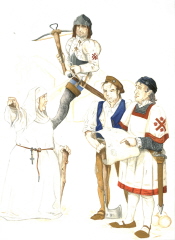The Two Armies Meet
 Lennox approached Haining Castle on the 4th September contemplating a difficult questions. Was he to carry out a full frontal attack on the Arran's troops on the heights opposite or was there some other route to Edinburgh? Would the Hamilton's fight at all or would they swap sides once they see the Lennox troops arrayed before them? Lennox's scouts soon presented him with another option. The Manuel Nunnery ford was only lightly guarded and could be crossed by the majority of the troops if not by the baggage and heavy guns. Surely if Arran sees his strong position outflanked he would think better of a full on fight? Lennox ordered his three wards to march on the ford leaving his heavy guns to deploy on Manuel Hill and commence an artillery duel with their opposite numbers across the water.
Lennox approached Haining Castle on the 4th September contemplating a difficult questions. Was he to carry out a full frontal attack on the Arran's troops on the heights opposite or was there some other route to Edinburgh? Would the Hamilton's fight at all or would they swap sides once they see the Lennox troops arrayed before them? Lennox's scouts soon presented him with another option. The Manuel Nunnery ford was only lightly guarded and could be crossed by the majority of the troops if not by the baggage and heavy guns. Surely if Arran sees his strong position outflanked he would think better of a full on fight? Lennox ordered his three wards to march on the ford leaving his heavy guns to deploy on Manuel Hill and commence an artillery duel with their opposite numbers across the water.
The Earl of Arran was playing for time. Lennox seemed to be moving south and he knew it was probably to the ford at Manuel. What could he do? He had not got enough men to man the whole ridge line opposite the crossing and moving off Pace Hill would lose some valuable height advantage and disrupt his formations. The best bet was to hold his ground and await the Douglases. He changed the face of his troops and sent out his missile men and light cavalry to contest the crossing, but otherwise he would sit and wait.
Lennox's fore ward led by the Master of Kilmaurs with his 2,000 horse now made their way to the ford through Whitecross. The Nunnery, normally bustling with activity, stood deserted. The few nuns and workers left on site welcomed the travellers and showed them to the ford then scurried off to prepare for the receipt of the inevitable wounded. As the first troops crossed they were met by a smattering of gun fire from the far bank. The horsemen deployed on the plain opposite then drove off the Hamilton skirmishes, allowing for the infantry to form up in relative peace.
Lennox, leading the main ward splashed across the ford around noon and watched on as his roops formed themselves into two blocks. The Earl of Glencairn was to take command of the right hand battle, Lennox the left. However even here at the widest point of the river valley the officers and sergeants found it difficult to form the two blocks side by side as the rising ground prevented the right hand column to fully extend it's frontage.
Time was pressing on and all ready the artillery duel was underway. Lennox outriders were also probing the defences at the bridge where the 200 Hamiltons retaliated from behind their barricades. For all Lennox knew, Angus may already be on the battlefield and the Edinburgh militia was probably on their way.The columns once deployed were now marched off to the sound of drums, psalms and cheers. The pikeman hoisted their weapons to their shoulders and began the advance up the river valley towards the waiting Hamiltons.
The closer the massive heaving blocks of men got to their enemy the greater the fall of shot and missiles amongst their ranks. The light guns set amid Arran's wards starting playing on the mass of men, sending small iron balls whistling into the throng knocking down men like skittles. Intermittent shots of harquebus and bow from the bluffs increased in intensity and accuracy as gunners and bowman plucked up courage to get a bit closer and started to find their range. Lennox's own gunners fanned out in front of the columns, taking on the Hamilton skirmishes at their own game. The phalanxes plodded on up the valley, with each step getting closer to the serried ranks up on Pace Hill.
The further the blocks marched on the more confusion was caused. The uneven and wet terrain made going difficult enough but the funnelling effect of the topography meant Glencairn's ward was forced against the Lennox men. Only when the valley widened again at the foot of Pace Hill could the whifflers and sergeants hope to realign and steady the column, all of which would have to be done with the enemy at hand.
The moment of crisis was now open both commanders. Would they fight? It seems almost impossible to a impartial viewer that these soldiers who must have had friends and relatives in the opposing ranks decided to come to blows and perhaps the arrival of Douglas tipped the balance. The Hamiltons advanced in to the Lennox men with the cries of 'A Douglas ' ringing in their ears. Whether Angus's men were there in any great force when the two sides met is impossible to say. What does appear to be the case is that the Hamiltons started the action and the Douglases finished it.

